The Intel Haswell-E CPU Review: Core i7-5960X, i7-5930K and i7-5820K Tested
by Ian Cutress on August 29, 2014 12:00 PM ESTOverclocked Results
As part of our reviews here at AnandTech we have recently been including a section on overclocked results, because in the end a +10% overclock does not always mean an extra +10% on performance. For our overclocking escapades mentioned earlier in the review, while we were able to achieve 4.6 GHz on the Core i7-5960X, the sweet spot was around 4.3 GHz at a very comfortable temperature. This leads to a +43% overclock over the base frequency, similar to what we saw with Sandy Bridge-E overclocking.
For our overclocking tests, we are using the same graphs as in the last two pages, but adding the data from our overclocked Sandy Bridge-E, Ivy Bridge-E, Haswell and Haswell-E CPUs as well, tested fresh for this review on our latest benchmark suite.
In the past overclocking was all about getting the same or better performance for a lower cost, however with Ivy Bridge-E due to its lower frequency, it was a battle to keep on par with Sandy Bridge-E. Now that Haswell-E has the same frequency deficit (200 MHz) but a +8% increase in IPC, it begs the question if Sandy Bridge-E users with good 4.8 GHz+ CPUs should consider upgrading (for anything other than more cores and an upgraded chipset).
SYSmark 2014

SYSmark sees the biggest uplift in its media and office benchmark suites when overclocked, although the financial suite does enjoy the more cores to put the 5960X ahead.
HandBrake v0.9.9: link
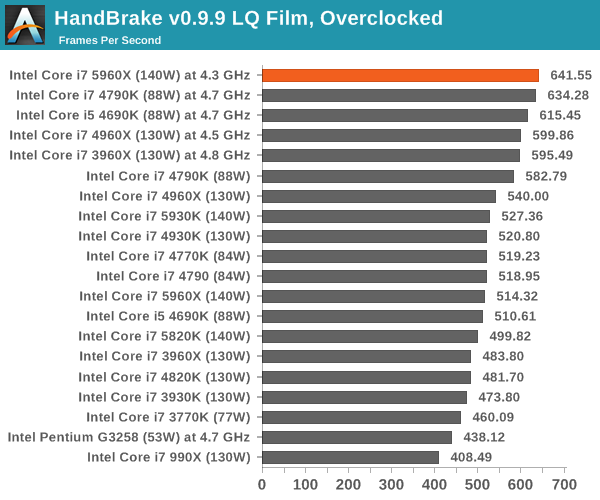
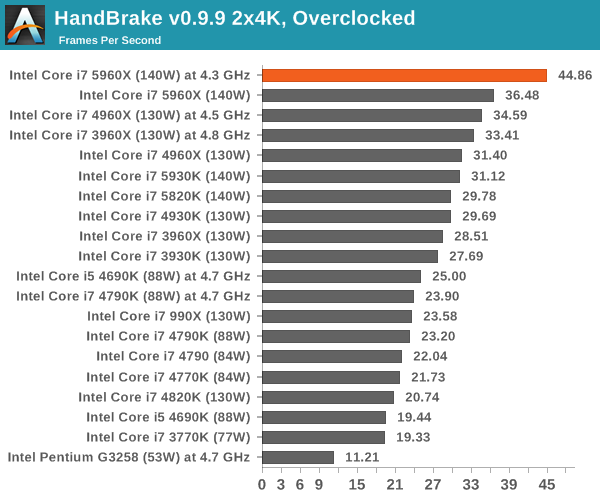
Interestingly the overclocked 5960X does aid low quality conversion, showing that with enough frequency all the cores can be constantly fed with data. The 5960X takes the top two spots for 4K conversion.
Agisoft Photoscan – 2D to 3D Image Manipulation: link

Photoscan also enjoys overclocking in combination with the cores, but the 3960X overclocked will beat the 5960X at stock despite the extra cores of the 5960X.
Dolphin Benchmark: link
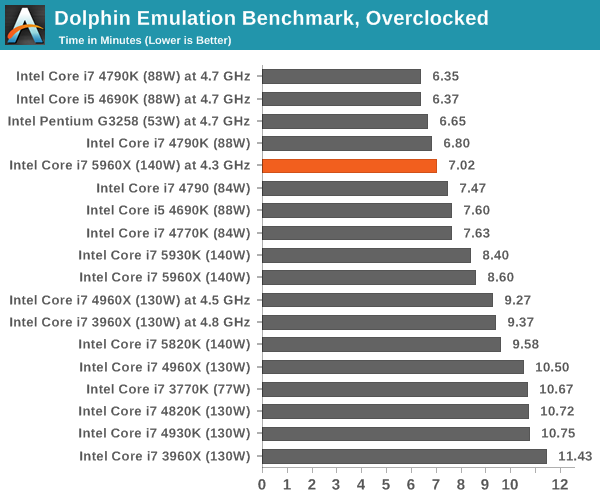
Dolphin prefers single threaded speed, so the Haswell CPUs at 4.7 GHz win here. Haswell does well in Dolphin's emulation overall, hence why the older extreme processors, even when overclocked, are further down.
WinRAR 5.0.1: link
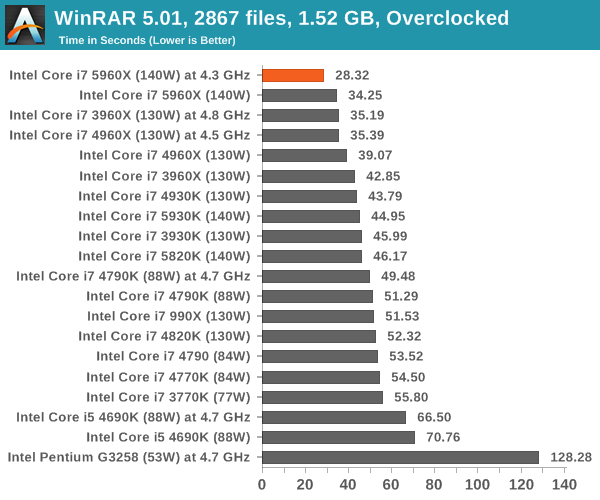
More top spots for the 5960X, with the two extra cores at stock beating the other extreme processors.
Hybrid x265
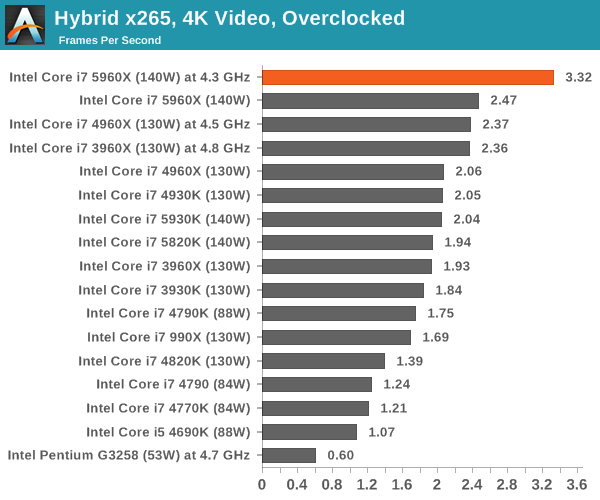
Cinebench R15
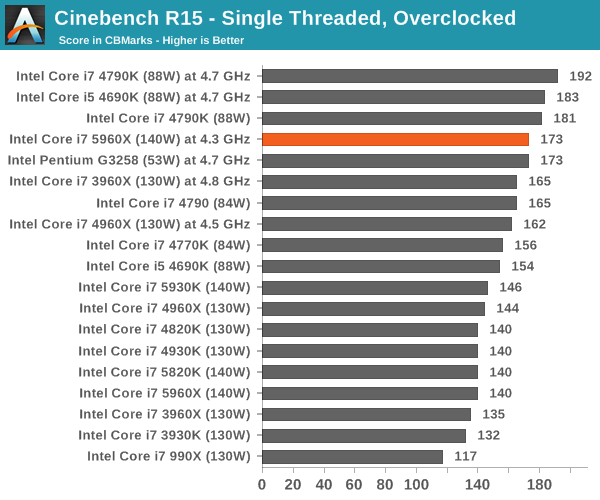
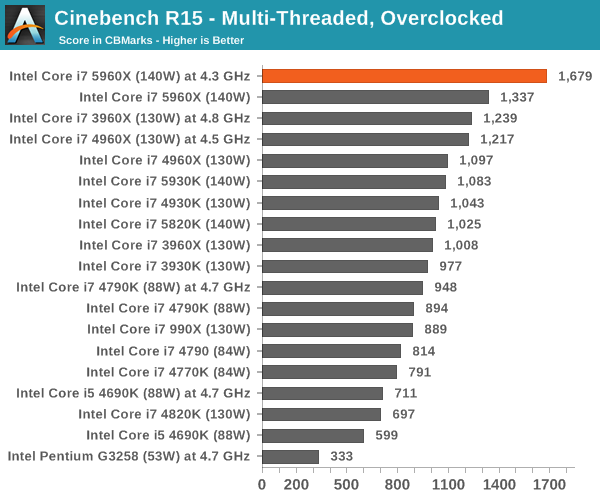
3D Particle Movement
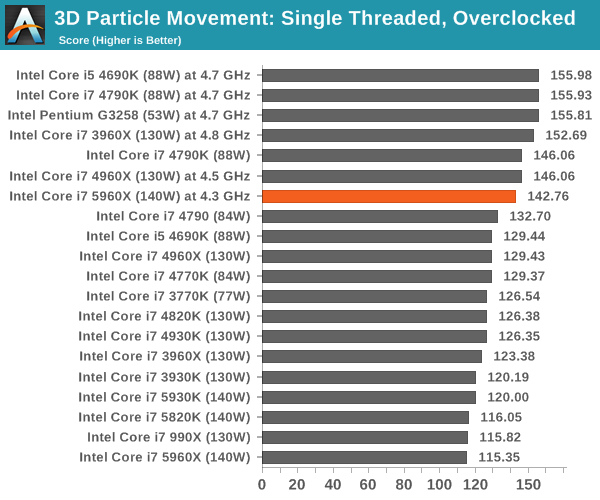
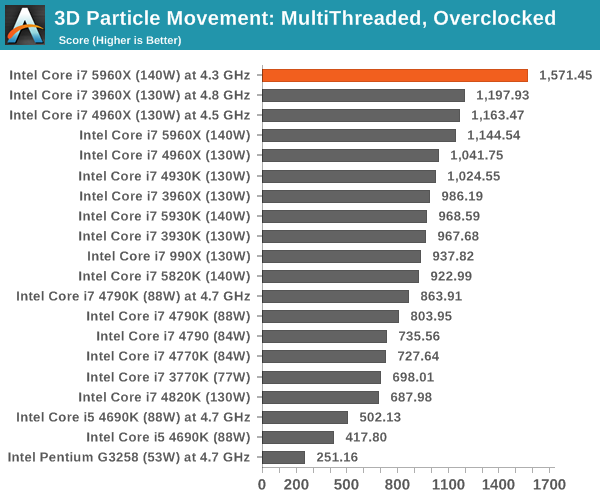
FastStone Image Viewer 4.9

When overclocked to 4.3 GHz, the 5960X would seem to produce a similar experience in FastStone to the 4790K at stock. This makes sense as the 4790K at stock is 4.4 GHz in turbo mode.
POV-Ray 3.7 Beta RC14
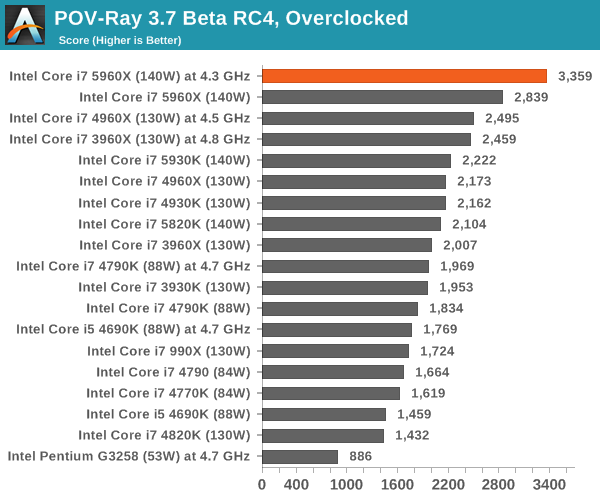
Gaming Benchmarks
F1 2013

The overclocked 5960X scores a few points in minimum frame rates, giving another +20% while in SLI.
Bioshock Infinite
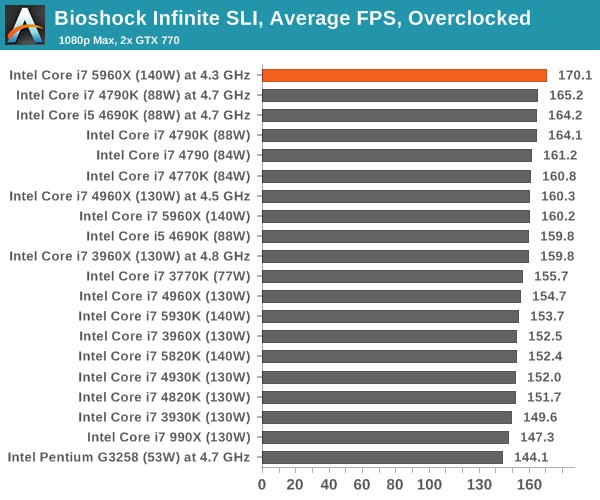
Bioshock average frame rates seem to get a small boost when overclocked, but minimum frame rates are more responsive to the 84W and 88W parts. The variation might be more indicative of the benchmark as a whole, as it only takes one errant slow frame to produce a low result in the minimum FPS results.
Tomb Raider
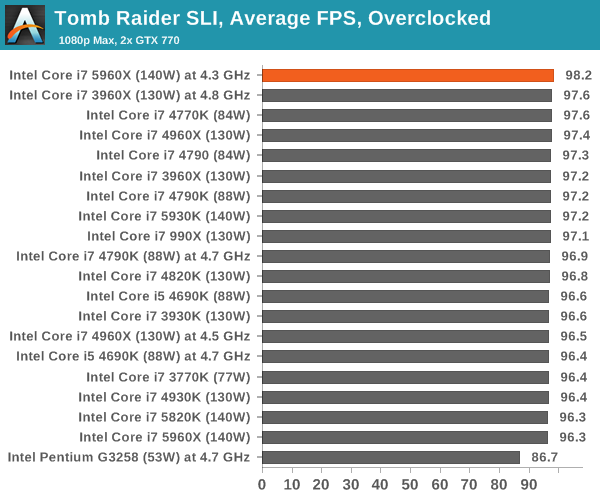
Sleeping Dogs
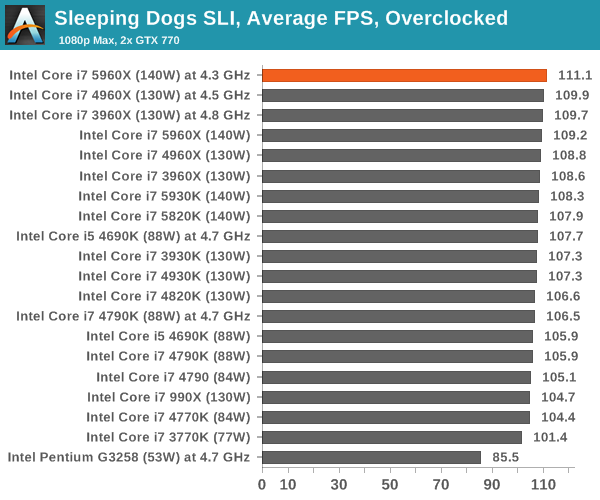
Battlefield 4
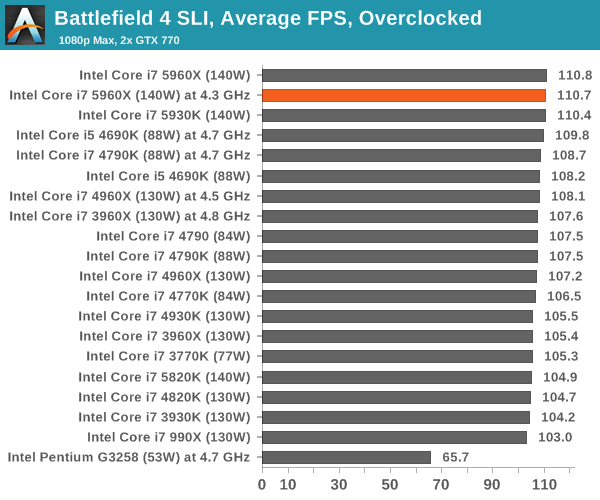
















203 Comments
View All Comments
schmak01 - Friday, January 16, 2015 - link
I thought the same thing, but it probably depends on the game. I got the MSI XPower AC X99s Board with the 5930K. when I was running a 2500k at 4.5 Ghz for years. I play a lot of FFXIV which is DX9 and therefore CPU strapped. I noticed a marked improvement. Its a multithreaded game so that helps, but on my trusty sandy bridge I was always at 100% across all cores while playing, now its rarely above 15-20%. Areas where Ethernet traffic picks up, high population areas, show a much better improvement as I am not running out of CPU cycles. Lastly Turnbased games like GalCivIII and Civ5 on absurdly large Maps/AI's run much faster. Loading an old game on Civ5 where turns took 3-4 minutes now take a few seconds.There is also the fact that when Broadwell-E's are out in 2016 they will still use the LGA 2011-3 socket and X99 chipset, I figured it was a good time to upgrade for 'future proofing' my box for a while.
Flunk - Friday, August 29, 2014 - link
Right, for rendering, video encoding, server applications and only if there is no GPU-accelerated version for the task at hand. You have to admit that embarrassingly parallel workloads are both rare and quite often better off handed to the GPU.Also, you're neglecting overclocking. If you take that into account the lowest-end Haswell-E only has a 20%-30% advantage. Also, I'm not sure about you but I normally use Xeons for my servers.
Haswell-E has a point, but it's extremely niche and dare I say extremely overpriced? 8-core at $600 would be a little more palatable to me, especially with these low clocks and uninspiring single thread performance.
wireframed - Friday, August 29, 2014 - link
The 5960X is half the price of the equivalent Xeon. Sure if you're budget is unlimited, 1k or 2k per CPU doesn't matter, but how often is that realistic.For content creation, CPU performance is still very much relevant. GPU acceleration just isn't up to scratch in many areas. Too little RAM, not flexible enough. When you're waiting days or weeks for renderings, every bit counts.
CaedenV - Friday, August 29, 2014 - link
improvements are relative. For gaming... not so much. Most games still only use 4 core (or less!), and rely more on the clock rate and GPU rather than specific CPU technologies and advantages, so having a newer 8 core really does not bring much more to the table to most games compared to an older quad core... and those sandy bridge parts could OC to the moon, even my locked part hits 4.2GHz without throwing a fuss.Even for things like HD video editing, basic 3D content creation, etc. you are looking at minor improvements that are never going to be noticed by the end user. Move into 4K editing, and larger 3D work... then you see substantial improvements moving to these new chips... but then again you should probably be on a dual Xeon setup for those kinds of high-end workloads. These chips are for gamers with too much money (a class that I hope to join some day!), or professionals trying to pinch a few pennies... they simply are not practical in their benefits for either camp.
ArtShapiro - Friday, August 29, 2014 - link
Same here. I think the cost of operation is of concern in these days of escalating energy rates. I run the 2500K in a little Antec MITX case with something like a 150 or 160 watt inbuilt power supply. It idles in the low 20s, if I recall, meaning I can leave it on all day without California needing to build more nuclear power plants. I can only cringe at talk about 1500 watt power supplies.wireframed - Friday, August 29, 2014 - link
Performance per watt is what's important. If the CPU is twice as fast, and uses 60% more power! you still come out ahead. The idle draw is actually pretty good for the Haswell-E. It's only when you start overclocking it gets really crazy.DDR4's main selling point is reduced power draw, so that helps as well.
actionjksn - Saturday, August 30, 2014 - link
If you have a 1500 watt power supply, it doesn't mean you're actually using 1500 watts. It will only put out what the system demands at whatever workload you're putting on it at the time. If you replaced your system with one of these big new ones, your monthly bill might go up 5 to 8 dollars per month if you are a pretty heavy user, and you're really hammering that system frequently and hard. The only exception I can think of would be if you were mining Bit Coin 24/7 or something like that. Even then it would be your graphics cards that would be hitting you hard on the electric bill. It may be a little higher in California since you guys get overcharged for pretty much everything.Flashman024 - Friday, May 8, 2015 - link
Just out of curiosity, what do you pay for electricity? Because I pay less here than I did when I lived in IA. We're at .10 KWh to .16 KWh (Tier 3 based on 1000KWh+ usage). Heard these tired blanket statements before we moved, and were pleased to find out it's mostly BS.CaedenV - Friday, August 29, 2014 - link
Agreed, my little i7 2600 still keeps up just fine, and I am not really tempted to upgrade my system yet... maybe a new GPU, but the system itself is still just fine.Let's see some more focus on better single-thread performance, refine DDR4 support a bit more, give PCIe HDDs a chance to catch on, then I will look into upgrading. Still, this is the first real step forward on the CPU side that we have seen in a good long time, and I am really excited to finally see some Intel consumer 8 core parts hit the market.
twtech - Friday, August 29, 2014 - link
The overclocking results are definitely a positive relative to the last generation, but really the pull-the-trigger point for me would have been the 5930K coming with 8 cores.It looks like I'll be waiting another generation as well. I'm currently running an OCed 3930K, and given the cost of this platform, the performance increase for the cost just doesn't justify the upgrade.